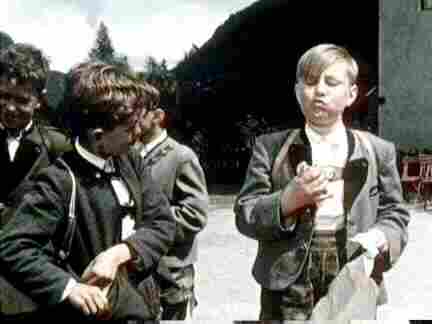
Figure 1.--Some choir have traveling uniforms such as lederhosen has depicted in this 1957 film.


Figure 1.--Some choir have traveling uniforms such as lederhosen has depicted in this 1957 film. |
"Almost Angels" is perhaps the best known film made about the Vienna Boys Choir, at least in America during the 1960s. Austrian and German movie goers may be more familiar with other films. I have not seen this film, but it has some important information on boys' clothing during the late 1950s and early 1960s. This movie seems to have quickly passed into obscurity as a piece of fluff unworthy of no more consideration than a dated 1960s travelogue. It is in the Disney vault, but they appear to give little attention to it. "Almost Angels" was filmed entirely on location in Austria, mostly in and around Vienna itself. The scenery is breathtaking; the music is splendid; and most of what you see inside the Augarten Palace--remains today just like it was during filming.
I have not seen this film, but it has some important information on boys' clothing during the late 1950s and early 1960s. One HBC contributor, however, reports that there is a Disney movie in which an "all-American" boy joins the Vienna Boys' Choir, albeit Austrian. The film was entitled Almost Angels (1962). Almost Angels appears to be the only color movie which has a boychoir as its entire theme. For many Americans this movie was their first introduction to not only the Vienna Choir Boys, but also to the world of boychoirs in general. A new member of the Vienna Boys' Choir (Vincent Winter), eleven years old, doesn't find himself overly welcomed since the lad assigned to be his mentor is envious of the recognition his voice is getting. Soon, though, these two are pals, and the younger develops a plan to help the older go on tour even though his voice is breaking. A charming film which should be appreciated by fans of boy choirs and boy soloists as well as by those who wish to be introduced to the subject. Full of lots of music and boyish fun.
This movie seems to have quickly passed into obscurity as a piece of fluff unworthy of no more consideration than a dated 1960s travelogue. It is in the Disney vault, but they appear to give little attention to it.
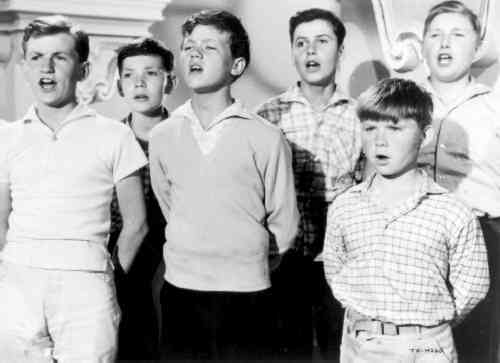
Figure 2.--Some scenes show the clothes worn by Austrian boys in the late 1950s and ealy 60s. HBC is not sure to what extent the clothes worn here by the boys are Disney costuming. |
"Almost Angels" did not have a major theatrical release, but rather went out on a double bill with the animated classic Lady and the Tramp reissue. The film was dubbed in German, Persian, Japanese, Spanish and Dutch/Flemish. It was subtitled in Portuguese for release in Brazil. The New York Times called it "...a wholesome...family film, attractive to the eye and ear." It was copyrighted by Disney in 1962. Except for being made available on 16mm rental copies, it was not heard from much again until being released on VHS in April of 1986. "Almost Angels videos were never placed on public sale but were sold only to rental outlets.
"Almost Angels" has been shown on The Disney Channel several times during the past 2 years, but at times around midnight when the only boys awake would be those with severe sleep disorders. Apparently Disney does not think the film would appear to the children who watch the channel during more reasonable hours.
"Almost Angels" was filmed entirely on location in Austria, mostly in and around Vienna itself. The scenery is breathtaking; the music is splendid; and most of what you see inside the Augarten Palace--remains today just like it was during filming.
"Almost Angels" is not just about boys singing. It presents a wonderful story which teaches much about friendship, honesty and loyalty. The film is the story of two Vienna choir boys who become best friends. They try to cover up the fact that one of them is losing his golden tones.
The story centers around two main characters. First Tony Fiala, who wanted to become a Vienna Choirboy. Tony who loves music and singing, auditions for the choir in spite of his father's objections. His "practical" does not share Tony's love of music. Father is afraid there will be no future for his son in music. Second, Peter, the other main character, is one of the senior Choirboy and natural leader. Peter sees the talented new boy as a serious rival to be dealt with by Peter.
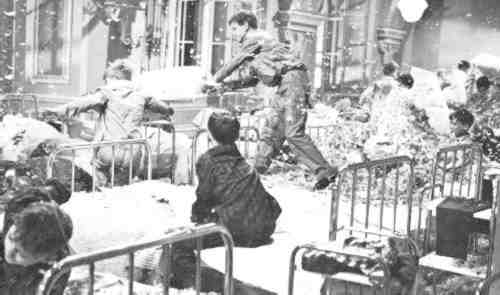
Figure 3.--This scene shows the dormitory where the choir boys lived. Here they are in the midst of a pillow fight. This was Peter's first attempt to get Tony into trouble. It began when Peter turned on Tony's radio. Tony said he was going to take it back home and asked Peter not to turn it on, saying, "We'll get into trouble." Peter replied, "YOU'LL get into trouble!": |
Not only is Tony quickly accepted, but his talents soon make choir boy leader Peter become concerned about his standing in the choir being threatened. The two boys begin as rivals. At first Peter does not like Tony because it seems like the choirmaster takes a liking to Tony and pushes Peter to the background. Perter at first decided to ignore the new boy, but this becomes difficult when the Choir director recognizes Tony's musical abilities. Herr Heller tells the two, "You sing well together." The relationship between the two, however, does not at forst go well.
The boys eventually become best of friends after Tony ignores several chances to get Peter into well-deserved trouble for his boyish pranks. In one scene, the choir director informs Peter that Tony had insisted that only he was responsible for having to make a dangerous 'window entrance' for a children's hospital concert from which they have just returned. Having failed twice to get the newcomer
into trouble, Peter now realizes that Tony does not hold grudges and is not going to inform on him. Thus begins a friendship which grows stronger and endures to the end of the film.
Disney used a mix of young actors and boys who were actual members of the famed Vienna Boys Choir at the time the film was shot. I do not know of any other film that the Choir participated in, but there may be some Austrian fiklms. It starred two boys who were quite busy child actors. One was Vincent Winter, a British actor, and the other was Sean Scully (who was the one also in The Prince And The Pauper). Another boy with an important role is a red-headed boy who plays Tony's friend, Friedel Schmidt. I'm not sure how common red hair was in Austria and Germany. The part is played by Dennis Gilmore. Freidel and Tony auctioned together (figure 2). The cast included: Vincent Winter, Sean Scully, Dennis Gilmore, Bernard Hindinger, Hennie Scott, Peter Weck, Hans Christian, Fritz Eckhardt, Hermann Furthmosek, Heinz Grohmann, Heidi Grübl, Hans Holt, Bruni Löbel, Gerda Maren, Gunther Philipp, Walter Regelsberger, Rose Renée Roth, Anni Schönhuber, Elisabeth Stiepl, Walter Varnda, Oskar Willner, Liselotte Wrede, as well as unamed members of the Vienna Choir Boys.
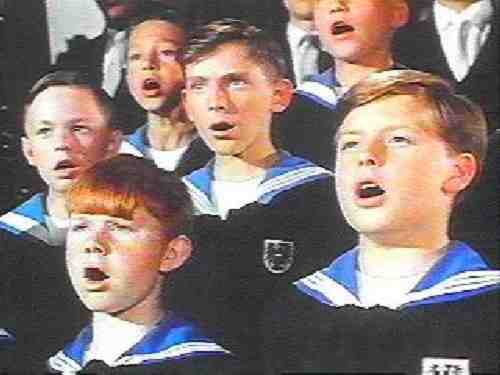
Figure 4.--The boys in the film wear both white and blue middy blouses. Notice the two shades of blue used in the sailor color. |
Peter Weck, who played Tony's and Peter's choir director Max Heller was reportedly a member of the choir when he was a boy. Throughout the story Herr Heller provides the boys with much needed lessons in cooperation. His part is so well played it is very obvious that he had been 'on both sides' of the podium. In the manner of all good boychoir directors, he shows sincere concern for the boys--not just for their singing! When Peter's voice breaks, the boy does not just regret not being allowed to go on the next world tour, but not being able to continue his composition studies under Heller. "You know what I'm getting at!" Peter tells him.
The fact that the Vienna Chour Boys actually participated in the film added some stuningly beautiful music to this basically low-budget film. Scenes are included with the boys solemly performing at high mass. They sing clasucs like rhe "Omnes de Saba venient". THey also sing some of the more light-hearted pieces that the Vienna Choir Boys use in their popular perfornmances.
Although not given a well publicized theatrical release, this film appears to have touched many Americans. I'm not sure about the raction in other countries. Here are some reviews prepared by various people who were touched by the film.
One reviewer reports, "Overall, it is a wonderful movie that gets you behind the scenes of what it is like being a Vienna Choirboy. I highly recommend it."
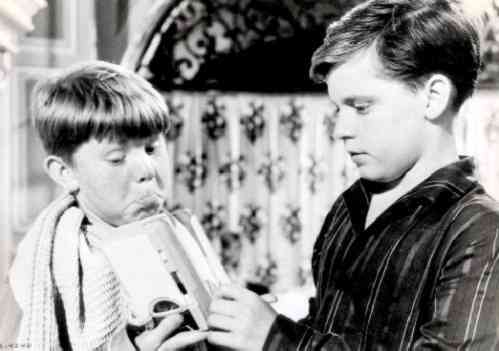
Figure 5.--Here in the dormitory the two main characters argue over the radio. |
Another reviwer goes on an on, but tells us very little about the film. He considered it himself when first viewing it in the cinema: "... as a contemporary of Peter and the other older choristers portrayed, shortly before perceiving what a precious experience it was to have enjoyed, even on a humbler scale and for only a matter of weeks, a similar experience. One could take such things (films and choirs) for granted in those days, but what a mistake that was: in the ensuing decades, boychoir after boychoir in America was sabotaged on whatever on ceivable pretext proved most expedient. They are now a gravely endangered species, as little sympathy as that may evoke from people oh-so-concerned about endangered species of other kinds. It was a movie, however, which I never forgot. I soon yearned to be able to see it again, and it has been quite galling to see it systematically neglected even in places which purport to specialize in offering Disney movies of the period. Finally finding it, I marveled at its authenticities: the fine music to which it treated the audience; the vocal training and technique which it adumbrated; the power and glory of possessing a beautiful treble voice, such that boys otherwise as eager as any to mature into manhood could shed tears at its passing. I doubt that any such genuine presentation would be considered viable for American audiences now. Surely such an attempt would be trivialized and bastardized today even to a much greater extent than perhaps it was then. Popular attention is finally devolving, if belatedly and only as an issue of self-preservation, upon the legacy of incompetence which socio-political trends have bequeathed to the raising of boys in the past generation. I commend this film, and the institution which it shows, as one redress whose value, proven over centuries, remains undiminished and ripe for recovery."
Hij heeft een mooie stem en als hij hoort dat er twee openingen zijn bij de Wiener Sängerknaben wil hij auditie doen. Ondanks twijfel
van zijn vader wordt hij aangenomen, en krijgt daardoor ook een zware opleiding zowel in muziek als in andere schoolvakken.
Schmaltzy but entertaining Disney film about two youngsters who
become friends in the Vienna Boys Choir. Pleasant story, fine music.
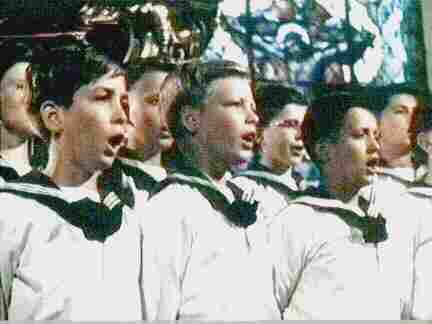
Figure 6.--The sailor suit is the most popular costume for German choirs. This is the white middy blouse uniform the boys wear. |
The boys in the film appear in the sailor suits worn by the Vienna Choir Boys. They also wear lederhosen and other casual clothes.
The sailor suits worn by the choir boys are authentic. The boys are shown in both the white and blue middy blouses as well as occasionally in their destinctive German-style sailor caps. The blue middy blouses employ two shades of blue. A brighter shade of blue is enployed in the sailor collar, both in the front and back flap. The blue middy blouses are worn with navy blue long pants. I believe the white middy blouses are worn with dark long pants. One one shade of navy blue is used in the collars of the white sailor suits. I'm not sure about the materail. I do not believe the boys in the film comment on their sailor suit uniforms. So I am not sure what theu thought about them.
The boys wear lederhosen in one outing. An image can be seen here above. Actually, these liederhosen images may be from another film. HBC recieves imahes from contributors who often do not know what film they are from. Hopefully a reader more familiar with this film can provide us more information.
HBC is less sure about some of the casual clothes the boys wear. It is unclear if the styles depicted are the styles worn by Austrian boys at the time or the result of Disney costuming and more reflective of Ametrican styles. HBC would be interested in hearing from viewers that may have some comments on this. HBC had thought that Austrian and German boys in the late 1950s and early 1960s commonly wore short pants , but this is not reflected in the film. The boys mostly wear long pants. Even in the boat, picnic scene the boys mostly wear long pants. This may be more of a reflection of Disney costuming than actual Austrian boys clothing.
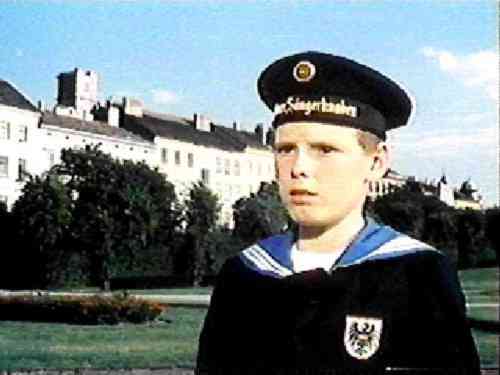
Figure 7.--The boys also appear in their German-style sailor caps as part of their uniforms. He is about to get a lecture from the choir director. |
A reviwer describes in a dramatic way the quality of the boys: "Many years ago, I attended a matinee performance of the Vienna Choir Boys which took place in San Diego. The alto soloist that day was a tall, lanky 13-year old kid named Bernhard Hiebsch. His solo that day was "Litanai" by Franz Schubert, which speaks about souls ascending to the Creator. Only later did I learn that Bernhard's own father had passed away that day, and he was told of his father's passing only moments before singing that solo. The audience never knew the depth of meaning of the magnificent performance they heard that day. Later, Bernhard was included in the Disney movie Almost Angels. He appears as one of the girls in the "dress rehearsal" of the operetta and can easily be identified by the thick glasses he wore. Subsequently, he was the alto soloist on one of the Mozart Mass recordings made during that era, unnamed and uncredited, of course, as was the tradition.
HBC know of only one other movie which dealt with the Vienna Choir Boys, the black and white film, Orphan Boy of Vienna.
Additional information is available in the music/choir section of HBC on Austrian choirs, but as far as HBC know, the Vienna Boys Choir is the only boy choir of any note in Vienna. The Vienna Choir Boys who are today so well known for their saolor suits intially wore army uniforma and only changed after World War I to less menacing looking sailor suits.
Navigate the Historic Boys' Clothing Web Site:
[Introduction]
[Activities]
[Biographies]
[Chronology]
[Cloth and textiles]
[Clothing styles]
[Countries]
[Topics]
[Bibliographies]
[Contributions]
[FAQs]
[Glossaries]
[Images]
[Satellite sites]
[Tools]
[Boys' Clothing Home]
Navigate the Historic Boys' Clothing Web choir costume pages:
[Return to the Main choir page]
[Return to the Main choir movie page]
[American movies]
[Austrian movies]
[French movies]
[German movies]
[Polish movies]
[Austria]
[Belgium]
[Bulgaria]
[Canada]
[Denmark]
[England]
[Finland]
[France]
[Germany]
[Ireland]
[Netherlands]
[Poland]
[South Africa]
[United States]
Navigate the Historic Boys' Clothing Web style pages:
[Short pants suits]
[Blazers]
[Collars]
[Lace collars]
[Ruffled collars]
[Peter Pan collars]
[Fauntleroy suits]
[Sailor suits]
[Ring bearer/page costumes]
[First Communion suits]